#fantasy worldbuilding
Text
Let's talk about writing fantasy.
Fantasy is one of my favourite genres, to read and to write. But the worldbuilding required and the existing tropes can make it difficult to craft a unique, compelling novel. There are a number of less-discussed nuances that might not always be at the forefront of writing discussions. Here are some tips to help you out:
Ground it in reality: Even though fantasy allows for boundless imagination, grounding your world in elements familiar to readers can make it more relatable and believable. Making it too otherworldly can make it difficult to understand or follow, and will likely make it much more difficult to interweave the explanation of your world and its society into the text seamlessly.
Consistency is key: Fantasy worlds can be complex, with their own rules, magic systems, and histories. Ensure consistency in your worldbuilding, avoiding contradictions or sudden changes without explanation. I find it helpful to keep a world bible or notes to track details and maintain coherence throughout the story.
Character-driven plots: While epic battles and magical quests are exciting, don't forget that compelling characters drive the heart of any story. Develop multi-dimensional characters with strengths, weaknesses, and personal arcs that resonate with readers (see my post on character development for more).
Avoid clichés and stereotypes: Fantasy often draws from familiar tropes and archetypes, but try not to rely on them too heavily. Subvert expectations and breathe new life into old conventions by adding unique twists or exploring lesser-known mythologies and cultures. Make it your own!
Magic has consequences: Magic adds wonder to fantasy worlds, but it should also have limitations and consequences. Consider the societal, environmental, and personal impacts of magic on your world and characters. A well-defined magic system can enhance the depth and realism of your story.
Worldbuilding through storytelling: Instead of dumping large chunks of exposition, reveal your fantasy world gradually through character interactions, dialogue, and plot progression. Show, don't tell, and let readers piece together the intricacies of your world as they journey through your story (check out my previous post on worldbuilding for more tips).
Embrace diversity: Fantasy worlds should reflect the diversity of our own world. Include characters from various backgrounds, cultures, and identities, and explore themes of inclusivity and acceptance within your narrative.
Conflict beyond good vs. evil: While the battle between good and evil is a classic fantasy trope, consider adding layers of moral ambiguity and complexity to your conflicts. Explore themes of power, redemption, and the consequences of choices made in the face of adversity.
Research is essential: Even in a world of imagination, research plays a crucial role in grounding your story in reality. Whether it's drawing inspiration from historical events, cultural practices, or scientific principles, thorough research can enrich your worldbuilding and add depth to your narrative. Even fantasy worlds and elements require some sort of basis to make them more believable.
Revise: Like any genre, writing fantasy requires extensive revision and polishing. Be prepared to revise your manuscript multiple times, seeking feedback from beta readers or critique partners to strengthen your story, characters, and worldbuilding.
Happy writing!
#writeblr#writing#writing tips#writing advice#writing help#writing resources#creative writing#plot development#worldbuilding#fantasy worldbuilding#fantasy#fantasy writing
69 notes
·
View notes
Text
I LOVE Dungeon Meshi's Realistic Fantasy Races
Ok, I had to stop for a moment to gush about the fantasy races of Dunmeshi, and all the consideration that's been put into them, because they actually follow a degree of natural/evolutionary logic not found in most fantasy stories!
Half-Foots (halflings/hobbits):

So we all know these fellows have excellent hearing and smell, but have you considered WHY? It's an adaptation to counteract their size. Humans (called tallmen in this setting) rely so much on eyesight because we're really tall compared to most animals, giving us a fantastic vantage of our environment. Half-Foots don't have this advantage, and therefore rely on their other senses. It's also much more important for them to be able to detect unseen threats and move quickly, because their size makes them ill-equipped for direct conflict.
Dwarves:
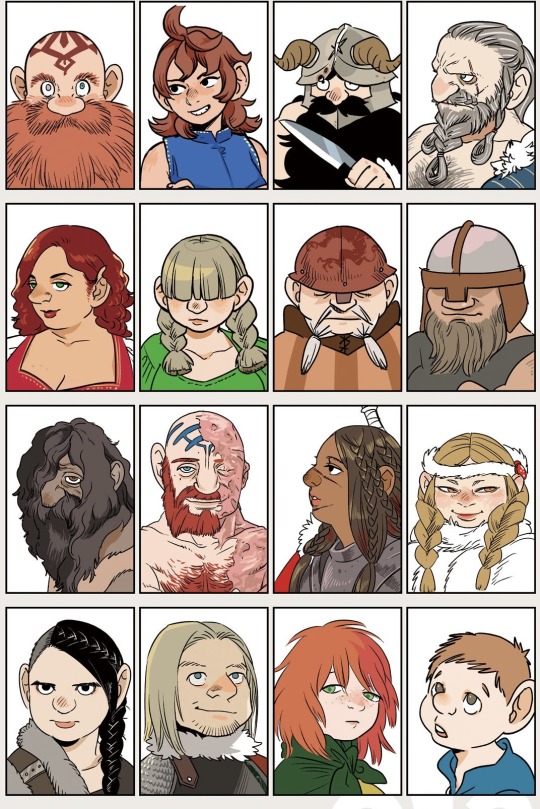
So Dwarves are depicted as MUCH stronger than tallmen despite their size, right? This is because strength is determined not by size, but by mass, and dwarven bodies are very dense! Yet this comes with the downside of their bodies burning more energy and overheating much faster, which is why dwarves are also shown to be heat-resistant, and why they tend to wear lighter clothing that exposes more skin! Their night-vision is also better than humans' due to their semi-underground lifestyle, while their hearing remains about the same since sound naturally carries in caves. Their hairiness is also likely a direct adaptation to counteract magic, as it's been shown to form a natural buffer when left unwashed.
Gnomes:
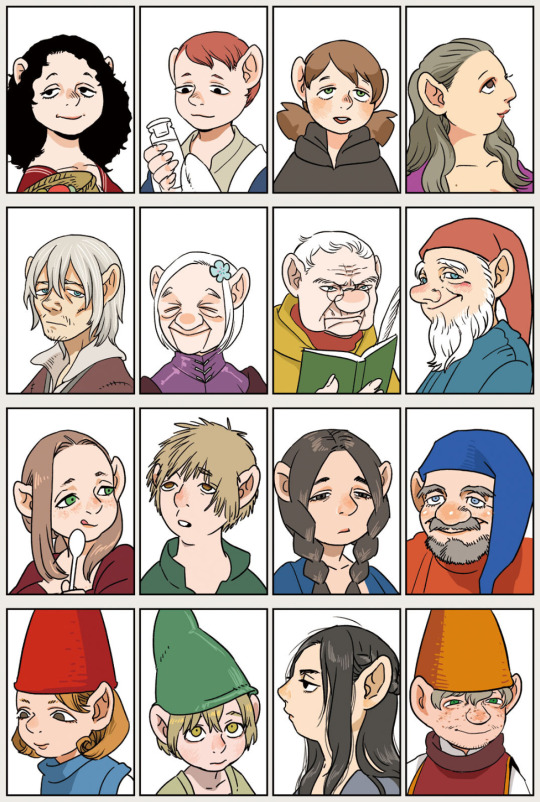
Gnomes are supposed to be evolutionary cousins to dwarves, and it shows! They share a similar height, but are less muscular and have peculiarly-shaped ears, almost mirroring the difference between human and elven ears. Their affinity with nature and spirits also makes sense, because physically they're in an awkward spot compared to the other short races, lacking both the hefty strength of dwarves and the light nimbleness of half-foots. Being less equipped both for fight and flight, it makes sense they'd instead adapt the instinctive ability to read their environments and mitigate its threats through cohabitation.
Elves:

Like gnomes, elves are in a physically awkward place, however it's even more extreme. Their relatively light and weak bodies make them ill-equipped for direct conflict, and while likely able to move faster than tallmen due to weight, they lack the half-foot's danger-detection senses. This makes them seemingly helpless, however interestingly it actually explains why they're so advanced compared to other races! They were basically forced to coordinate problem-solve, and control their environments out of necessity, which is reflected in their more controlling and direct relationship with magic and nature compared to gnomes.
This actually mirrors the real-world difference between humans and neanderthals. Anthropologists believe neanderthals weren't actually dumber than humans, but that their superior strength and durability meant they weren't forced to problem-solve or control their environments like humans, meaning they seemed less advanced.
2K notes
·
View notes
Text
World Building Checklist
Have you ever started writing a story and realized your world has a bunch of unexplained shit and you have to fill in the gaps as you go? Me too, buddy. Me too. Here’s a checklist so that you can fully flesh out your world to the max. (I’m dying)
How does Time work? (Minutes, hours, days, the daylight cycle, years, ect.)
Species (if Fantasy. Will probably make another post on this.)
Countries, Nations, Tribes, ect. (nationalities/ races. Will probably make another post on this.)
The geography of the world (draw a map. Doesnt have to be good. Just for a general idea.)
Rivalries between races (includes prejudice, racism, ect.)
Religions
Technology
The Magic system. (Will probably make a whole other post on this.)
animals, plants, ect.
The sky: Sun, Moon(s), Stars, Constellation, Are there rings? (If the planet has rings)
Educations system
Government system
Politics
Methods of transport (Vehicles)
Medicine
Can’t really think of anything else. If you have more to add then reblog and add to the list! :) bye bee
#writing advice#how to write#creative writing#writers on tumblr#writing#writeblr#world#world building#fantasy worldbuilding#fantasy writing#fantasy tips#Fantasy world building tips#Writing tips
2K notes
·
View notes
Text
a list of 100+ buildings to put in your fantasy town
academy
adventurer's guild
alchemist
apiary
apothecary
aquarium
armory
art gallery
bakery
bank
barber
barracks
bathhouse
blacksmith
boathouse
book store
bookbinder
botanical garden
brothel
butcher
carpenter
cartographer
casino
castle
cobbler
coffee shop
council chamber
court house
crypt for the noble family
dentist
distillery
docks
dovecot
dyer
embassy
farmer's market
fighting pit
fishmonger
fortune teller
gallows
gatehouse
general store
graveyard
greenhouses
guard post
guildhall
gymnasium
haberdashery
haunted house
hedge maze
herbalist
hospice
hospital
house for sale
inn
jail
jeweller
leatherworker
library
locksmith
mail courier
manor house
market
mayor's house
monastery
morgue
museum
music shop
observatory
orchard
orphanage
outhouse
paper maker
pawn shop
pet shop
potion shop
potter
printmaker
quest board
residence
restricted zone
sawmill
school
scribe
sewer entrance
sheriff's office
shrine
silversmith
spa
speakeasy
spice merchant
sports stadium
stables
street market
tailor
tannery
tavern
tax collector
tea house
temple
textile shop
theatre
thieves guild
thrift store
tinker's workshop
town crier post
town square
townhall
toy store
trinket shop
warehouse
watchtower
water mill
weaver
well
wind mill
wishing well
wizard tower
#worldbuilding#setting prompts#writer resources#writing inspiration#writing prompts#scene settings#writing reference#writing ideas#prompt list#creative writing#writing community#writer prompts#writing tips#world#fantasy world#fantasy worldbuilding#high fantasy#world building#epic fantasy#writing fantasy
2K notes
·
View notes
Text

Collectable woodblock prints commemorating individual conquests were commonplace in the theocracy, distributed by the church as a way to announce its victories.
get a print here :>
#setting: mez#just wanted to draw something mindless & fun tonight. what's up#medieval bestiary art#fantasy worldbuilding#pantera got the final blow in with aid from the other pictured beests
3K notes
·
View notes
Text
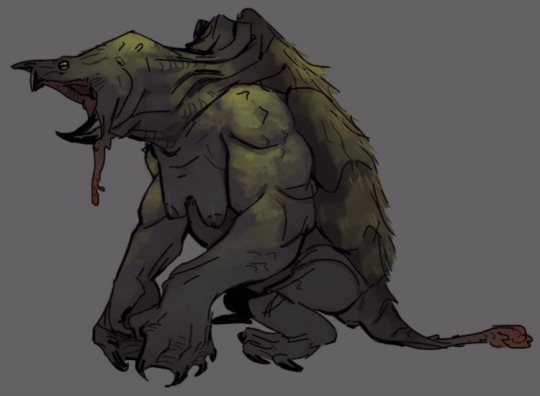
River/bridge troll. Humans tend to build bridges over “inconvenient” bodies of water, which is coincidently where there be trolls.
1K notes
·
View notes
Text
on worldbuilding, and what people think is going on
there is one facet of fantasy worldbuilding that is, to me, the most interesting and essential but i don't see it come up in worldbuilding guides or writing prompts or anything, and that is the question of:
what do the inhabitants of your world believe about how the world works, and how are they wrong? a lot of fantasy media will set up their cosmology, gods, magic systems, planar systems, concepts of the afterlife, &c., and proceed as though the inhabitants of the world know and understand them.
from someone whose entire academic career is focused on studying human culture in various regions and time periods, with a focus on belief systems (religion, occultism, mythology, folklore): that sort of worldbuilding is unrealistic and missing out on so much fun.
people are always seeking new understanding about how the world works, and they are mostly wrong. how many models of the solar system were proposed before we reached our current one? look at the long, turbulent history of medicine and our various bizarre models for understanding the human body and how to fix it. so many religions and occult/magical traditions arise from people disagreeing with or adapting various models of the world based on new ideas, methods, technologies. many of them are wrong, but all of them are interesting and reflect a lot about the culture, beliefs, values, and fears of the people creating/practising them.
there is so much more to the story of what people believe about the world than just what is true.
to be clear: i think it's fine and important for the author to have a coherent explanation for where magic comes from or who the gods are, so they can maintain consistency in their story. but they should also be asking what people in the world (especially different people, in different regions/nations and different times) think is happening when they do magic, or say a prayer, or practise medicine, or grieve their dead. it is a rich vein for conflict between individuals and nations alike when two models of the world disagree. it is fascinating how different magic systems might develop according to different underlying beliefs.
personally, i think it is the most fun to spawn many diverse models of the world, but give none of them the 'right' answer.
(bonus points if you also have a thriving academic system in the world with its own theory, research, and discourse between factions! as an academic, it is very fun to imagine fictional academic debate over the topics i'm worldbuilding. sometimes i will be working out details for some underlying mechanic of the world and start imagining the papers being written by scholars researching it)
1K notes
·
View notes
Text
Insults (Fantasy Edition)
They're as useful as a wet blanket in the middle of winter
I could talk to my horse and have a better conversation
She did love her family, but she'd rather have an ocean between her and them.
He was the kind of man to stumble across rational thought quite by accident and dismiss it as absurd
'Quite frankly, I'd rather eat Hemlock.'
I know the gods do not exist, because if they did, they would've struck you down by now.
Well, you're clearly got some troll ancestry.
That's probably the wisest thing you've ever said and yet still you are wrong.
Do you just sit there all day and hope some sort of sentient through floats in your direction
She was tolerable. From a distance.
They were often wrong but never in doubt.
#writing#writing prompt#writing prompts#creative writing#writeblr community#fantasy prompts#prompt#writeblr#hero x villain#prompts#story prompts#fantasy worldbuilding#fantasy#writing fantasy#fantasy insults
2K notes
·
View notes
Text
A tutorial on a (bit cheating) way of creating fictional maps.
Open your editing software (RECOMMENDING Krita, since it's free and it's very good).
Step 1: Google "X country silhouette" and copy it.

Paste it onto the canvas.
Step 2:
Separate the silhouette from the background you copied with it! You can do that by using magic wand selection tool or by making a gradient map with black on 49,9% and transparent on 50% on the slider.


Step 3: Repeat several times with numerous countries and/or islands, cities, municipalities, communes, continents et cetera.
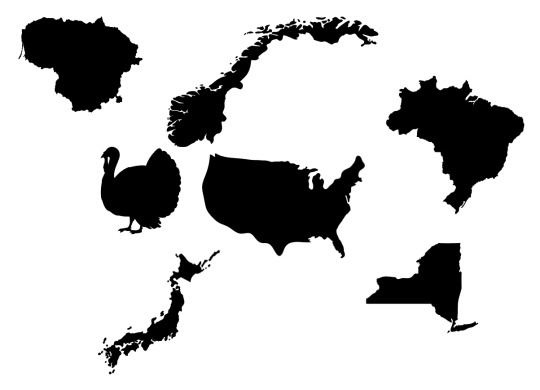
Step 4: Combine, mesh, stretch, rotate, mirror - go ham, make it work.
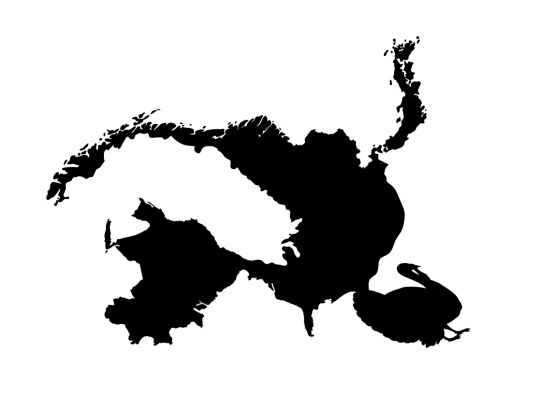
Step 5: Erase and add.
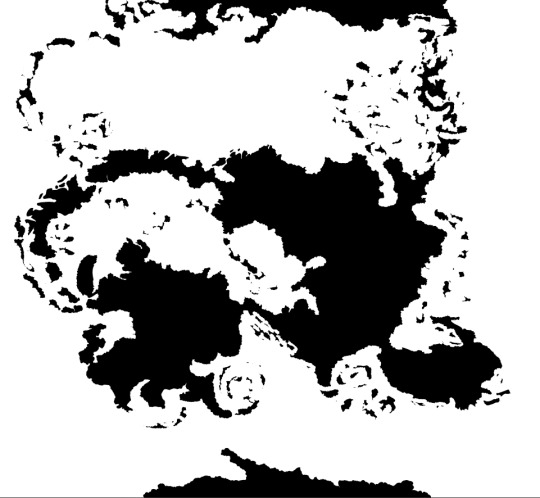
Step 6: Have your map outline ready, copy/paste it several times in the same doc on different layers and edit in different ways like biomes, kingdoms, mountains and other.
Step Mountains+: To figure out mountains, make another layer on the doc and do something like this:
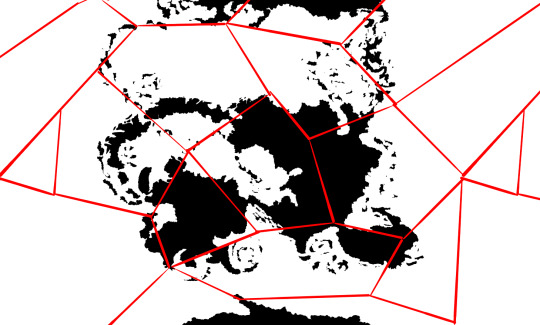
-and then in every polygon you add an arrow.
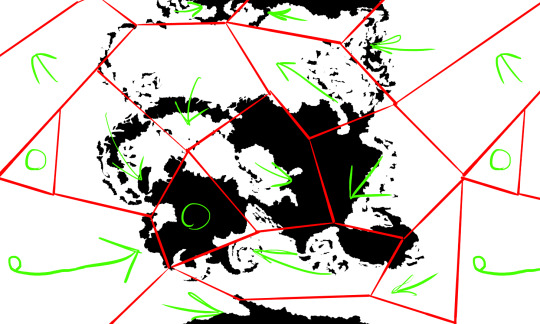
Where arrows meet or transfer onto continents, add mountains.
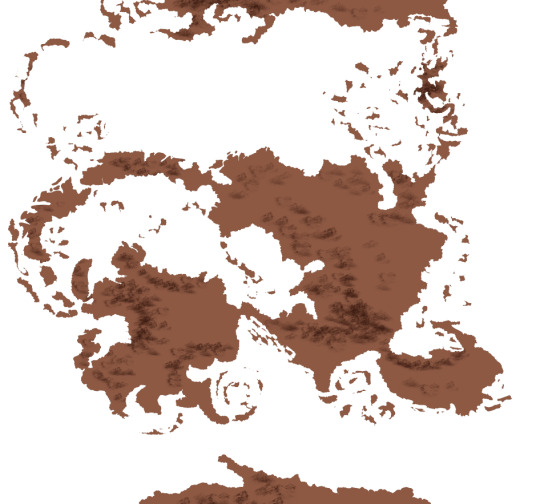
Color the sea with a couple layers of depth and you're done :D


#cartography#making maps#fantasy world#making fantasy maps#fantasy worldbuilding#worldbuilding map#map#maps
8K notes
·
View notes
Text
Don't fall in love with angels. They're allowed to love you and will do nice things for you. But they still serve heaven and its rules before they serve any being in the universe. The nicest, kindest, angel that you could ever meet, will still watch as thousands die because it's the will of fate, would still smite the undead just for being what they are. If they believe you're someone wrong or evil, even if you're just 'born wrong' they will destroy you. Their fire may warm you, but it's still there to burn heretics.
Fall in love with demons, those angels that have left heaven's will. They may be cruel at times, they all fell for different reasons, and many of them don't take well to being asked to say why. But they have their own will, and if you convince them to do good, they will do good. Even the darkest of demons can be reasoned with, because they already had enough reason to abandon the sky. Their fire may burn you, but it is the torch of liberty.
#angel#angels#angelcore#demon#demons#my worldbuilding#fantasy worldbuilding#worldbuilding#my words#my writing#writeblr#fantasy#writers on tumblr#writers#196#my thougts#writing#urban fantasy#my wriitng#cosmic#heaven#hell
2K notes
·
View notes
Text



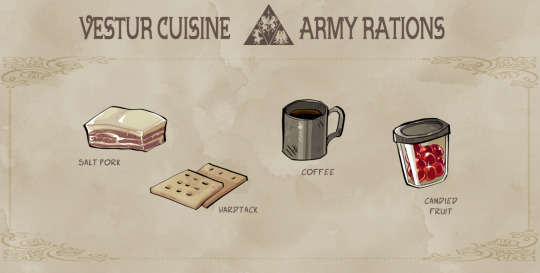
Foods of Vestur
@broncoburro and @chocodile provoked me into doing some illustrated worldbuilding for Forever Gold ( @forevergoldgame ), an endeavor I was happy to undertake. Unbeknownst to me, it would take the better part of a week to draw.
In the process, I conjured about an essay's worth of fantasy food worldbuilding, but I'm going to try and keep things digestible (pardon my pun). Lore under the cut:
The Middle Kingdom
The Middle Kingdom has ample land, and its soil, landscapes, and temperate climate are amenable to growing a variety of crops and raising large quantities of livestock. The Midland palate prefers fresh ingredients with minimal seasoning; if a dish requires a strong taste, a cook is more likely to reach for a sharp cheese than they are to open their spice drawer. Detractors of Middle Kingdom cuisine describe it as bland, but its flavor relies on the quality of its components more than anything.
KEY CROPS: wheat, potatoes, carrots, green beans, apples, pears, and grapes
KEY LIVESTOCK: Midland goats, fowl, and hogs
ROAST FOWL: Cheap and easy to raise, fowl is eaten all over Vestur and by all classes. Roasted whole birds are common throughout, but the Middle Kingdom's approach to preparation is notable for their squeamish insistence on removing the head and neck before roasting, even among poorer families. Fowl is usually roasted on a bed of root vegetables and shallots and served alongside gravy and green beans.
GOAT RIBEYE: Vestur does not have cattle – instead it has a widely diversified array of goats, the most prominent being the Middle Kingdom's own Midland goat. The Midland goat is a huge caprid that fills the same niche as cattle, supplying Vestur with meat and dairy products. Chevon from the Midland goat is tender with a texture much like beef, though it retains a gamier, “goat-ier” taste. It is largely eaten by the wealthy, though the tougher and cheaper cuts can be found in the kitchens of the working class. Either way, it is almost always served with gravy. (You may be sensing a pattern already here. Midlanders love their gravy.)
FETTUCCINE WITH CHEESE: Noodles were brought to the Middle Kingdom through trade with the South and gained popularity as a novel alternative to bread. The pasta of Midland Vestur is largely eaten with butter or cream sauce; tomato or pesto sauces are seldom seen.
CHARCUTERIE WITH WINE: Charcuterie is eaten for the joy of flavors rather than to satiate hunger, and therefore it is mainly eaten by the upper class. It is commonly eaten alongside grape wine, a prestigious alcohol uniquely produced by the Middle Kingdom. The flavor of grape wine is said to be more agreeable than the other wines in Vestur, though Southern pineapple wine has its share of defenders.
BREAD WITH JAM AND PRESERVES, TEA SANDWICHES, & ROSETTE CAKE: Breads and pastries are big in the Middle Kingdom. The Middle Kingdom considers itself the world leader in the art of baking. Compared to its neighbors, the baked goods they make are soft, light, and airy and they are proud of it. Cakes in particular are a point of ego and a minor source of mania among nobility; it is a well-established cultural joke that a Middle Kingdom noble cannot suffer his neighbor serving a bigger, taller cake. The cakes at Middle Kingdom parties can reach nauseatingly wasteful and absurdist heights, and there is no sign of this trend relenting any time soon.
CHOWDER, FARMER'S POT PIE, GRIDDLECAKES, EGGS, CURED MEATS: If you have the means to eat at all in the Middle Kingdom, you are probably eating well. Due to the Midland's agricultural strength, even peasant dishes are dense and filling. Eggs and cured meats are abundant, cheaper, and more shelf stable than fresh cuts and provide reprieve from the unending wheat and dairy in the Midland diet.
STEWED APPLES AND PEARS, JAM AND PRESERVES: The Midland grows a number of different fruits, with apples and pears being the most plentiful. In a good year, there will be more fruit than anyone knows what to do with, and so jams and preserves are widely available. Stewed fruit has also gained popularity, especially since trade with the Southern Kingdom ensures a stable supply of sugar and cinnamon.
NORTHERN KINGDOM - SETTLED
The Northern Kingdom is a harsh and unforgiving land. Historically, its peoples lived a nomadic life, but since the unification of the Tri-Kingdom more and more of the Northern population have opted to live a settled life. The “settled North” leads a hard life trying to make agriculture work on the tundra, but it is possible with the help of green meur. The Northern palate leans heavily on preserved and fermented foods as well as the heat from the native tundra peppers. Outsiders often have a hard time stomaching the salt, tang, and spice of Northern cuisine and it is widely considered “scary.”
KEY CROPS: potatoes, beets, carrots, tundra pepper
KEY LIVESTOCK: wooly goats, hares*
GOAT POT ROAST: Life up north is hard work and there is much to be done in a day. Thus, slow cooked one-pot meals that simmer throughout the day are quite common.
VENISON WITH PICKLES: Game meat appears in Northern dishes about as much as farmed meat – or sometimes even more, depending on the location. Even “classier” Northern dishes will sometimes choose game meat over domesticated, as is the case with the beloved venison with pickles. Cuts of brined venison are spread over a bed of butter-fried potato slices and potent, spicy pickled peppers and onions. The potatoes are meant to cut some of the saltiness of the dish, but... most foreigners just say it tastes like salt, vinegar, and burning.
MINER STEW: While outsiders often have a hard time distinguishing miner stew from the multitude of beet-tinged stews and pot roasts, the taste difference is unmistakable. Miner's stew is a poverty meal consisting of pickles and salt pork and whatever else is might be edible and available. The end result is a sad bowl of scraps that tastes like salt and reeks of vinegar. The popular myth is that the dish got its name because the Northern poor began putting actual rocks in it to fill out the meal, which... probably never happened, but facts aren't going to stop people from repeating punchy myths.
RYE TOAST WITH ONION JAM: Rye is hardier than wheat, and so rye bread is the most common variety in the North. Compared to Midland bread, Northern bread is dense and gritty. It is less likely to be enjoyed on its own than Midland bread, both because of its composition and because there's less to put on it. Unless you've the money to import fruit spreads from further south, you're stuck with Northern jams such as onion or pepper jam. Both have their appreciators, but bear little resemblance to the fruit and berry preserves available elsewhere in Vestur.
HARE DAIRY: Eating hare meat is prohibited in polite society due to its association with the haretouched and heretical nomadic folk religions, but hare dairy is fair game. Hare cheese ranges from black to plum in color, is strangely odorless, and has a pungent flavor akin to a strong blue cheese. It is the least contentious of hare milk products. Hare milk, on the other hand, is mildly toxic. If one is not acclimated to hare milk, drinking it will likely make them “milk sick” and induce vomiting. It is rarely drunk raw, and is instead fermented into an alcoholic drink similar to kumis.
MAPLE HARES AND NOMAD CANDY: Maple syrup is essentially the only local sweetener available in the North, and so it is the primary flavor of every Northern dessert. Simple maple candies are the most common type of sweet, though candied tundra peppers – known as “nomad candy” – is quite popular as well. (Despite its name, nomad candy is an invention of the settled North and was never made by nomads.)
TUNSUKH: Tunsukh is one of the few traditions from the nomadic era still widely (and openly) practiced among Northern nobility. It is a ceremonial dinner meant as a test of strength and endurance between political leaders: a brutally spiced multi-course meal, with each course being more painful than the last. Whoever finishes the dinner with a stoic, tear-streaked face triumphs; anyone who cries out in pain or reaches for a glass of milk admits defeat. “Dessert” consists of a bowl of plain, boiled potatoes. After the onslaught of tunsukh, it is sweeter than any cake.
NORTHERN KINGDOM – NOMADIC NORTH
Although the Old Ways are in decline, the nomadic clans still live in the far North beyond any land worth settling. They travel on hareback across the frozen wasteland seeking “meur fonts” - paradoxical bursts of meur that erupt from the ice and provide momentary reprieve from the harsh environment. The taste of nomad food is not well documented.
KEY CROPS: N/A
KEY LIVESTOCK: hares
PEMMICAN: Nomadic life offers few guarantees. With its caloric density and functionally indefinite “shelf life,” pemmican is about as close as one can get.
SEAL, MOOSE: Meat comprises the vast majority of the nomadic diet and is eaten a variety of ways. Depending on the clan, season, and availability of meur fonts, meat may be cooked, smoked, turned to jerky, or eaten raw. Moose and seal are the most common sources of meat, but each comes with its own challenges. Moose are massive, violent creatures and dangerous to take down even with the aid of hares; seals are slippery to hunt and only live along the coasts.
WANDER FOOD, WANDER STEW: When a green meur font appears, a lush jungle springs forth around it. The heat from red meur fonts may melt ice and create opportunities for fishing where there weren't before. Any food obtained from a font is known as “wander food.” Wander food is both familiar and alien; the nomads have lived by fonts long enough to know what is edible and what is not, but they may not know the common names or preparation methods for the food they find. Fish is simple enough to cook, but produce is less predictable. Meur fonts are temporary, and it's not guaranteed that you'll ever find the same produce twice - there is little room to experiment and learn. As a result, a lot of wander food is simply thrown into a pot and boiled into “wander stew,” an indescribable dish which is different each time.
CENVAVESH: When a haretouched person dies, their hare is gripped with the insatiable compulsion to eat its former companion... therefore, it is only proper to return the favor. Barring injury or illness, a bonded hare will almost always outlive its bonded human, and so the death of one's hare is considered a great tragedy among nomads. The haretouched – and anyone they may invite to join them – sits beside the head of their hare as they consume as much of its rib and organ meat as they can. Meanwhile, the rest of the clan processes the remainder of the hare's carcass so that none of it goes to waste. It is a somber affair that is treated with the same gravity as the passing of a human. Cenvavesh is outlawed as a pagan practice in the settled North.
HARE WINE: While fermented hare's milk is already alcoholic, further fermentation turns it into a vivid hallucinogen. This “hare wine” is used in a number of nomad rituals, most notably during coming of age ceremonies. Allegedly, it bestows its drinker with a hare's intuition and keen sense of direction... of course, truth is difficult to distinguish from fiction when it comes to the Old Ways.
SOUTHERN KINGDOM
The Southern Kingdom is mainly comprised of coast, wetland, and ever-shrinking jungle. While the land is mostly unfit for large-scale agriculture, seafood is plentiful and the hot climate is perfect for exorbitant niche crops. What they can't grow, they obtain easily through trade. Southerners have a reputation for eating anything, as well as stealing dishes from other cultures and “ruining” them with their own interpretations.
KEY CROPS: plantains, sweet potato, pineapple, mango, guava, sugarcane
KEY LIVESTOCK: fowl, marsh hogs, seals
GLAZED EEL WITH FRIED PLANTAINS: A very common configuration for Southern food is a glazed meat paired with a fried vegetable. It almost doesn't matter which meat and which vegetable it is – they love their fried food and they love their sweet and salty sauces in the South. Eel is a culturally beloved meat, much to the shock and confusion of visiting Midlanders.
NARWHAL STEW: Narwhal stew is the South's “anything goes” stew. It does not actually contain narwhal meat, as they are extinct (though the upper class may include dolphin meat as a protein) – instead, the name comes from its traditional status as a “forever soup,” as narwhals are associated with the passage of time in Southern culture. Even in the present day, Southern monasteries tend massive, ever-boiling pots of perpetual stew in order to feed the monks and sybils who live there. Narwhal stew has a clear kelp-based broth and usually contains shellfish. Beyond that, its ingredients are extremely varied. Noodles are a popular but recent addition.
FORAGE: The dish known as “forage” is likewise not foraged, or at least, it hasn't been forage-based in a good hundred years at least. Forage is a lot like poke; it's a little bit of everything thrown into a bowl. Common ingredients include fish (raw or cooked), seaweed, fried noodles, marinated egg, and small quantities of fruit.
HOT POT: Hot pot is extremely popular, across class barriers, in both the South proper and its enclave territories. This is due to its extreme flexibility - if it can be cooked in a vat of boiling broth, it will be. Crustaceans and shellfish are common choices for hot pot in the proper South, along with squid, octopus, mushrooms, and greens.
FLATBREAD: The Southern Kingdom doesn't do much baking. The vast majority of breads are fried, unleavened flatbreads, which are usually eaten alongside soups or as wraps. Wraps come in both savory and sweet varieties; savory wraps are usually stuffed with shredded pork and greens while sweet wraps – which are much more expensive – are filled with fruit and seal cheese.
GRILLED SKEWERS, ROAST SWEET POTATO: While a novel concept for Midlanders and Northerners, street food has long been a part of Southern Kingdom culture. You would be hard pressed to find a Southern market that didn't have at least three vendors pushing grilled or fried something or other. Skewers are the most common and come in countless configurations, but roast sweet potatoes are a close second.
CUT FRUIT AND SEAL CHEESE: Fresh fruit is popular in the South, both local and imported. While delicious on its own, Southerners famously pair it with seal cheese. Which leads me to an important topic of discussion I don't have room for anywhere else...
THE SOUTH AND CHEESE: Since the South doesn't have much in the way of dairy farming, cheese is somewhat rare in their cuisine – but it is present. And important. Cheese is the domain of the Church. Common goat dairy imported from the Middle Kingdom is turned to cheese by monks in Southern monasteries and sold to the Southern public, yes, but as you have noticed there is another cheese prominent in the Southern Kingdom diet: seal cheese. Seal cheese is unlike anything else that has ever been called cheese; the closest it can be compared to is mascarpone. It is is a soft, creamy cheese with a mild flavor and an indulgent fat content. It is used almost exclusively as a dessert, though it is only ever mildly sweetened if at all. It is extremely costly and held in high regard; the most religious Southerners regard it as holy. Dairy seals are a very rare animal and raised exclusively in a small number of Cetolist-Cerostian monasteries, where they are tended and milked by the monks. Due to their status as a holy animal, eating seal meat is forbidden. Eating their cheese and rendering their tallow into soap is fine though.
(HEARTLAND SOUTH) SOUTH-STYLE GOAT: The Heartland South is a Southern enclave territory in the Middle Kingdom. Visiting Midland dignitaries oft wrongly assume that because the Heartland South is in Middle Kingdom territory, Heartland Southerners eat the same food they do exactly as they do. They are horrified to find that familiar sounding dishes like “goat with potatoes” are completely and utterly unrecognizable, drenched in unfamiliar sauces and spices and served alongside fruit they've never eaten. Meanwhile, Heartland Southerners firmly believe that they have fixed the Middle Kingdom's boring food.
(BOREAL SOUTH) “TUNSUKH”: If Midlanders are afraid of Heartland Southern food, Northerners are absolutely furious about cuisine from the Boreal South - the most legendarily offensive being the Boreal South's idea of “tunsukh.” Southerners are no stranger to spice, so when Southern traders began interacting with the North, they liked tunsukh! It's just... they thought it needed a little Southern help to become a real meal, you know? A side of seal cheese soothed the burn and made the meal enjoyable. And because the meal was enjoyable, the portion sizes increased. And plain boiled potatoes? Well, those are a little too plain – creamy mashed sweet potato feels like more of a dessert, doesn't it? ...For some reason, Northerners didn't agree, but that's okay. The Boreal South knows they're just embarrassed they didn't think of pairing seal cheese with tunsukh sooner.
ARMY RATIONS
The food eaten by the King's Army is about what you would expect for late 1700s military; salt pork or salt chevon, hard tack, and coffee. The biggest divergence they have is also one of Vestur's biggest points of pride: they have the means to supply their troops with frivolous luxuries like small tins of candied fruit from the Midland. A love of candied fruit is essentially a Vesturian military proto-meme; proof that they serve the greatest Tri-Kingdom on the planet. Don't get between a military man and his candied fruit unless you want a fight.
#verse: forever gold#worldbuilding#fantasy worldbuilding#food worldbuilding#fantasy food#food art#animal death//#might have to proofread this later forgive any typos I am tired
507 notes
·
View notes
Text
Let's talk about worldbuilding.
Worldbuilding is a crucial aspect of writing fiction, particularly in genres like fantasy and science fiction.
Remember that worldbuilding is a dynamic process that evolves as you write. Don't be afraid to experiment and make changes to your world as needed to serve the story.
Here are some tips to help you build a rich and immersive world:
Start with a Core Concept: Every world begins with an idea. Whether it's a magic system, a futuristic society, or an alternate history, have a clear concept that serves as the foundation for your world.
Define the Rules: Establish the rules that govern your world, including its physical laws, magic systems, societal norms, and cultural practices. Consistency is key to creating a believable world.
Create a Detailed Map: Optional, but helpful. Develop a map of your world to visualise its geography, including continents, countries, cities, and landmarks. Consider factors like climate, terrain, and natural resources to make your world feel authentic.
Build a History: Develop a rich history for your world, including key events, conflicts, and historical figures. Consider how past events have shaped the present and influenced the cultures and societies within your world.
Develop Cultures and Societies: Create diverse cultures and societies within your world, each with its own beliefs, traditions, languages, and social structures. Explore how different cultures interact and conflict with one another.
Flesh Out Characters: Populate your world with memorable characters who reflect its diversity and complexity. Consider how their backgrounds, motivations, and personalities are shaped by the world around them. (See my post on character development for more!)
Consider Technology and Magic: Determine the level of technology and the presence of magic in your world, and how they impact daily life, society, and the overall narrative.
Think about Economics and Politics: Consider the economic systems, political structures, and power dynamics within your world. Explore issues like inequality, governance, and social justice to add depth to your worldbuilding.
Show, Don't Tell: Instead of dumping information on readers, reveal details about your world gradually through storytelling. Show how characters interact with their environment and incorporate worldbuilding seamlessly into the narrative.
Stay Consistent: Maintain consistency in your worldbuilding to ensure coherence and believability. Keep track of details like character names, historical events, and geographic locations to avoid contradictions.
Leave Room for Exploration: While it's essential to have a solid foundation for your world, leave room for discovery and exploration as you write. Allow your world to evolve organically and be open to new ideas and possibilities.
Revise and Edit: Carefully review your worldbuilding to identify any inconsistencies, plot holes, or contradictory elements. Pay attention to details such as character backgrounds, historical events, and the rules of your world's magic or technology. Make necessary revisions to resolve any issues and maintain the integrity of your worldbuilding.
Happy writing!
#writeblr#writing#writing tips#writing help#writing resources#writing advice#worldbuilding#fantasy worldbuilding#creative writing
574 notes
·
View notes
Text
A writer’s guide to the historical method: how historians work with sources
In this post, I provide a brief overview of how historians engage with different types of sources, with a focus on the mindset of a historian. This insight could be valuable for anyone crafting a character whose profession revolves around history research. It may also prove useful for authors conducting research for their book.
Concept of historical source
The concept of historical source evolves over time.
Initially, the focus was mainly on written sources due to their obvious availability. However, as time has progressed, historians now consider a wide range of sources beyond just written records. These include material artifacts, intangible cultural elements, and even virtual data.
While "armchair historians" may rely on existing studies and secondary sources, true professional historians distinguish themselves by delving directly into primary sources. They engage in a nuanced examination of various sources, weaving together diverse perspectives. It's crucial to recognize the distinction between personal recollection or memory and the rigorous discipline of historical inquiry. A historical source provides information, but the truth must be carefully discerned through critical analysis and corroboration.
Here's a concise list of the types of sources historians utilize:
Notarial source
Epistolary source
Accountancy source
Epigraphic source
Chronicle source
Oratory and oral source
Iconographic source
Diary source
Electronic source
Example: a notarial source
These are documents drafted by a notary, a public official entrusted with providing legal certainty to facts and legal transactions. These documents can take various forms, such as deeds, lawsuits, wills, contracts, powers of attorney, inventories, and many others.
Here we are specifically discussing a lawsuit document from 1211 in Italy.
A medieval lawsuit document is highly valuable for understanding various aspects of daily life because in a dispute, one must argue a position. From lawsuits, we also understand how institutions truly operated.
Furthermore, in the Middle Ages, lawsuits mostly relied on witnesses as evidence, so we can access a direct and popular source of certain specific social situations.
Some insight into the methodology of analysis:
Formal examination: historians scrutinize the document's form, verifying its authenticity and integrity. Elements such as structure, writing style, language, signatures, and seals are analyzed. Indeed, a professional historian will rarely conduct research on a source published in a volume but will instead go directly to the archive to study its origin, to avoid transcription errors.
Content analysis: historians proceed to analyze the document's content, extracting useful information for their research. This may include data on individuals, places, events, economic activities, social relations, and much more. It's crucial to compile a list of witnesses in a case and identify them to understand why they speak or why they speak in a certain manner.
Cross-referencing with other sources: information derived from the notarial source is compared with that of other historical sources to obtain a more comprehensive and accurate view of the period under examination.
Documents of the episcopal archive of Ivrea
Let's take the example of a specific legal case, stemming from the documents of the episcopal archive of Ivrea. It's a case from 1211 in Italy involving the bishop of Ivrea in dispute with Bongiovanni d'Albiano over feudal obligations.
This case is significant because it allows us to understand how feudal society operated and how social status was determined.
The bishop's representative argues that Bongiovanni should provide a horse as a feudal service. Bongiovanni denies it, claiming to be a noble, not a serf. Both parties present witnesses and documents supporting their arguments.
Witnesses are asked whether the serf obligations had been endured for a long time. This helps us understand that in a society where "law" was based on customs, it was important to ascertain if an obligation had been endured for a long time because at that point it would no longer be contestable (it would have become customary).
The responses are confused and inconsistent, so witnesses are directly asked whether they consider Bongiovanni a serf or a noble. This is because (and it allows us to understand that) the division into "social classes" wasn't definable within concrete boundaries; it was more about the appearance of one's way of life. If a serf refused to fulfill his serf duties, he would easily be considered a noble by bystanders because he lived like one.
Ultimately, the analysis of the case leads us to determine that medieval justice wasn't conceived with the logic of our modern system, but was measured in oaths and witnesses as evidentiary means. And emerging from it with honor was much more important than fairly distributing blame and reason.
Other sources
Accounting source: it is very useful for measuring consumption and its variety in a particular historical period. To reconstruct past consumption, inventories post mortem are often used, which are lists of goods found in households, described and valued by notaries to facilitate distribution among heirs.
Alternatively, the recording of daily expenses, which in modern times were often very detailed, can lead to insights into complex family histories and their internal inequalities - for example, more money might be spent on one child than another corresponding to their planned future role in society.
Oral source: in relation to the political sphere, it is useful for representing that part of politics composed of direct sources, that is, where politics speaks of itself and how it presents itself to the public, such as a politician's public speech.
However, working with this type of source, a historian cannot avoid hermeneutic work, as through the speech, the politician aims to present himself to a certain audience, justify, persuade, construct his own image, and achieve results. This is the hidden agenda that also exists in the most obvious part of politics.
Iconographic source: it concerns art or other forms of "artistic" expression, such as in the case of an advertising poster. They become historical sources when it is the historian who, through analysis, confers upon them the status of a historical source. Essentially, the historian uses the source to understand aspects of the past otherwise inaccessible.
The first step in this direction is to recontextualize the source, returning it to its original context. Examining the history of the source represents the fundamental first step for historical analysis.
Diary source: diaries are a "subjective" source, a representation of one's self, often influenced by the thoughts of "others," who can be close or distant readers, interested or distracted, visible or invisible, whom every diary author can imagine and hope to see, sooner or later, reflected on the pages of their writing.
Furthermore, they are often subject to subsequent manipulations, and therefore should be treated by historians only in their critical edition; all other versions, whether old or new, foreign or not, are useful only as evidence of the changes and manipulations undergone over time by the original manuscripts.
Electronic source: historians use Wikipedia even if they often don't admit it out loud.
This blog is supported through tips here on Tumblr. If you’d like to support me, please consider giving a tip.
#writing advice#writing help#writing reference#writing tips#creative writing#fantasy worldbuilding#fantasy writing#worldbuilding#worldbuilding tips
287 notes
·
View notes
Text

#art#science fantasy#fantasy world#dark fantasy#fantasy art#fantasy aesthetic#fantasy worldbuilding#church#gothic art#gothic girl#gothic architecture#gothic aesthetic#ai art#ai artist#aiartcommunity#ai generated#ai artwork#ai image#ai art generator#ai digital art#ai
632 notes
·
View notes
Text
Based off a convo I had with a friend so I'm curious fellow storytellers! Pick the one you most relate to if you relate to multiple. Reblog for sample size please!
566 notes
·
View notes
Text
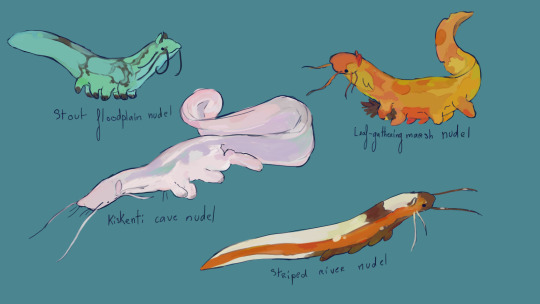
Some various species of nudelu!
The stout floodplain nudel inhabits the rolling hills part of the Nalken area in Omikti's breath. It lays its eggs in large puddles, so that they have plenty of humidity to hatch and grow for their first few days in water, but can do so in water devoid of predators.
The Kiskenti cave nudel is a slow-moving, blind animal, but their whiskers are longer and more sensitive. Due to living in caves where food is scarce, they have the ability to remain unmoving for months, or even years, slowing their metabolism until a prey passes by.
The leaf-gathering marsh nudel is a quick and intelligent creature, that spends less time in water once it can walk, and instead takes to the damp floor of swamps, grabbing and lifting leaves with its two front paws to eat the creatures hiding in the leaf litter.
The striped river nudel, on the other hand, spends almost all of its time within water; a fast swimmer, they appreciate clear, pure waters and can be found high within mountain streams. They can do impressive jumps out of water to catch insects.
#okali#fantasy#wandering okali#species#art#graphi's things#worldbuilding#speculative biology#specbio#xenobiology#creature design#spec bio#speculative zoology#fantasy creature#fantasy worldbuilding#xenofiction
226 notes
·
View notes